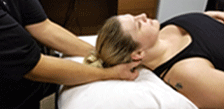|
 A female with low back pain was
seen in physical therapy and was found to have decrease hamstring
flexibility. A measurement of hamstring flexibility involving the
90/90 test (popliteal angle test) yielded results of 35 degrees for
B hamstrings. Prior to participating in physical therapy, the
patient states she had been performing hamstring stretches on her
own by lying on the floor by placing her leg in a straight/extended
position with heel up against the wall. Patient states she did feel
like this was an effective stretch but was wondering if there was
more she could do to help improve her hamstring flexibility without
contributing to additional stresses on her back. After performing a
search on Pub Med she came across research studies that concluded
the use of suboccipital muscle inhibition was effective with helping
improve hamstring flexibility. She brought this to my attention when
I evaluated her and I reviewed the articles afterwards which
garnered these results:
A female with low back pain was
seen in physical therapy and was found to have decrease hamstring
flexibility. A measurement of hamstring flexibility involving the
90/90 test (popliteal angle test) yielded results of 35 degrees for
B hamstrings. Prior to participating in physical therapy, the
patient states she had been performing hamstring stretches on her
own by lying on the floor by placing her leg in a straight/extended
position with heel up against the wall. Patient states she did feel
like this was an effective stretch but was wondering if there was
more she could do to help improve her hamstring flexibility without
contributing to additional stresses on her back. After performing a
search on Pub Med she came across research studies that concluded
the use of suboccipital muscle inhibition was effective with helping
improve hamstring flexibility. She brought this to my attention when
I evaluated her and I reviewed the articles afterwards which
garnered these results:
According to Schleip (1) if the tone of the suboccipital muscles is
decreased either passively, with a fascial treatment, or with active
movements, the length of the hamstring would be greater due to
relaxation of the myofascia. This can be associated with the
hamstrings and suboccipital muscles being part of a continuous link
of the neural system which passes through the dura mater (2).
In the research study by Apracio EQ, et al. published in 2009 (3)
they examined a sample size of 70 individuals with short hamstring
syndrome who were randomly separated into an intervention group
(n=36) that were subjected to suboccipital muscle inhibition (SMI)
technique and a placebo group (n=34) that were subjected to a
placebo treatment. Pre and postintervention evaluation tests which
included finger-floor distance test (FFD), the straight leg raise
test (SLR) and the popliteal angle test (PAT) were used for the
assessment of hamstring elasticity. Their study concluded that the
SMI technique was able to increase hamstring flexibility in an
immediate fashion as measured with the FFD test, the SLR test, and
the PAT test.
In the research study by Cho SH, et al. published in 2015 (4) they
examined 50 subjects with short hamstrings and separated them
randomly into a group that would receive suboccipital muscle
inhibition (SMI) (n=25) and a self myofascial release group (SMFR)
(n=25). Pre and postintervention evaluation tests which included
finger-floor distance test (FFD), the straight leg raise test (SLR)
and the popliteal angle test (PAT) were used for the assessment of
hamstring elasticity. Their study concluded that the SMI group had a
significant change in FFD, SLR and PA and a change in SLR was found
in the SMFR group.
In another study by Dave N, et al. published in 2017 (5) they
examined 45 subjects with hamstring tightness and randomly separated
them into three groups: Group A (Suboccipital muscle inhibition
technique), Group B (Doming of Diaphragm technique) and Group C
(both techniques). Each subject was assessed before and immediately
after the treatment using the popliteal angle test, sit and reach
test and straight leg raise test. Their study concluded that the
combination of suboccipital muscle inhibition technique and Doming
of Diaphragm technique was effective with improving flexibility
immediately in subjects with hamstring tightness.
The three research studies seem to support the use of SMI technique
to achieve immediate gains with hamstring flexibility. However, the
three studies did display some limitations, could have utilized a
larger sample size and could have provided more detailed
information. Nevertheless, I was curious to see if performing SMI
technique on my patient would assist in achieving improved hamstring
flexibility. The 90/90 test (popliteal angle test) was conducted
before performing the SMI technique which yielded results of 35
degrees for B hamstrings. After performing the SMI technique the
90/90 test was conducted again and yielded results of 25 degrees
Left & 27 degrees Right. Surprisingly this was a gain of 10 degrees
and 8 degrees respectively for hamstring flexibility. Even though
positive results were achieved, I would be interested in utilizing a
larger sample size and performing additional and more thorough
research. Go ahead and give it a try and see if you can help your
patient achieve gains with hamstring flexibility!
Last revised: December 19, 2018
by Chai Rasavong, MPT, COMT, CMTPT, MBA
References
1) Schleip R. Rolfing and the neuro-myofascial net. Boulder: Rolf
lines; 1996.
2) Hack G, et al. Anatomic Relation between the rectus capitis
posterior minor muscle and dura mater. Spine 1995;20:2484-6
3) Aparicio EQ, et al. Immediate effects of the suboccipital muscle
inhibition technique in subjects with short hamstring syndrome. J
Manipulative Physiol Ther, 2009, 32:262-269
4) Cho SH, et al. The comparison of the immediate effects of
application of the suboccipital muscle inhibition and
self-myofascial release techniques in the suboccipital region on
short hamstring. J Phys Ther Sci, 2015, 27:195-197
5) Dave N, et al. Individual and combined effect of suboccipital
muscle inhibition technique and Doming Diaphragm Technique for
hamstring tightness. Int J Pharm Bio Sci, 2017, 8(2): B 980-988
|
